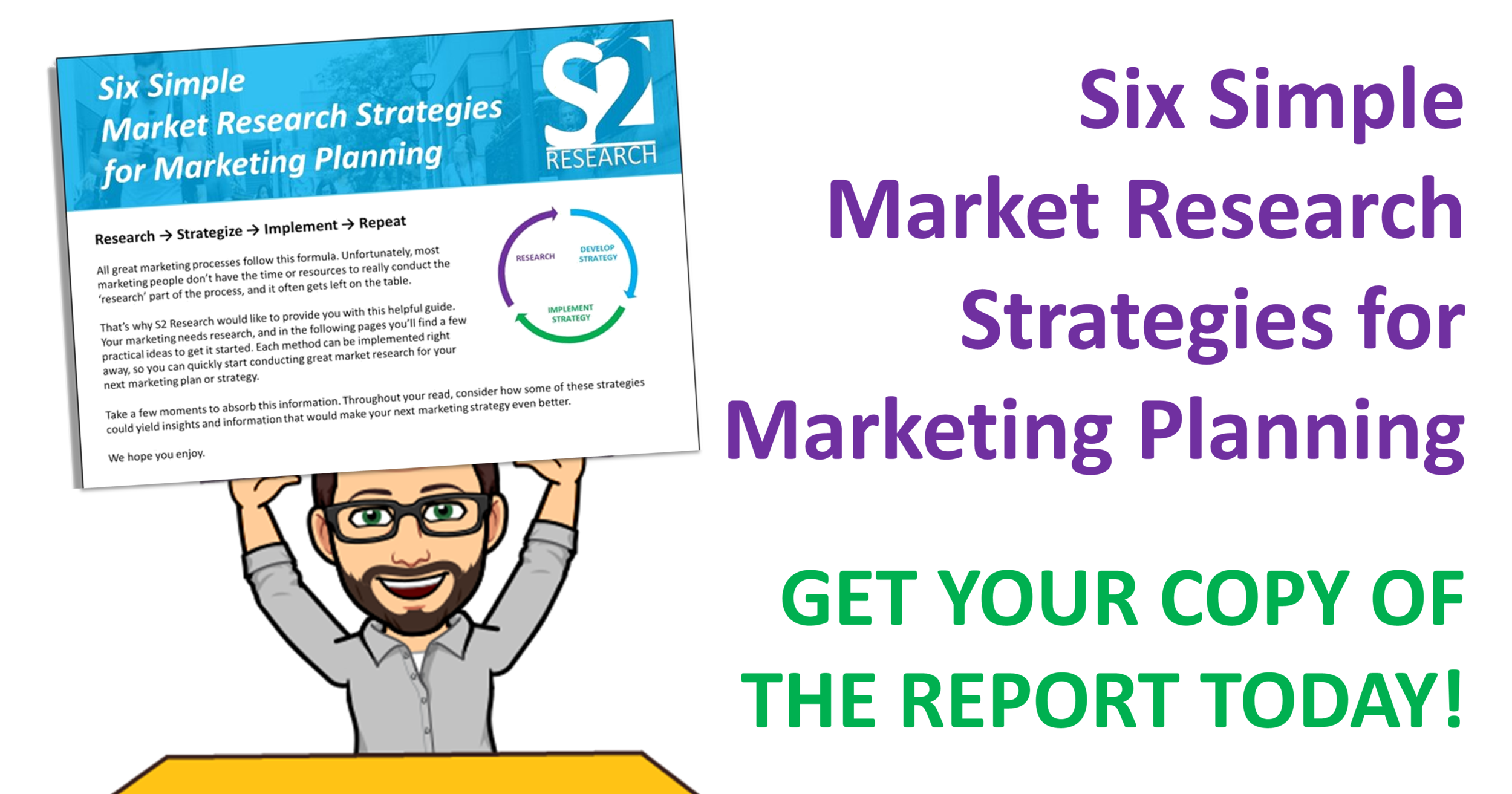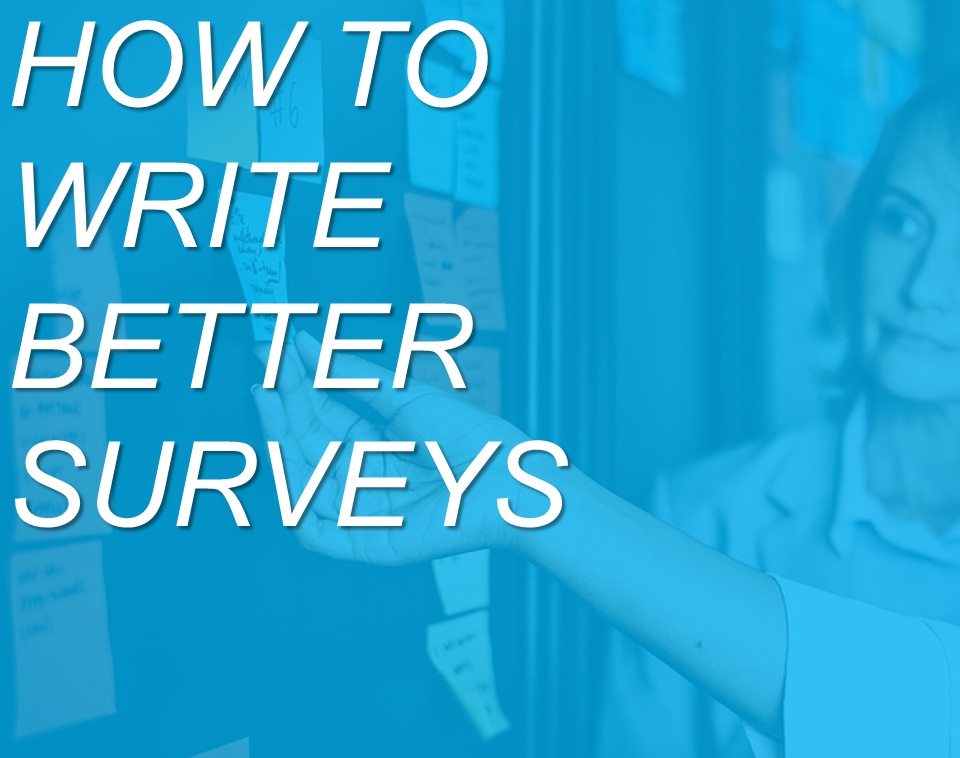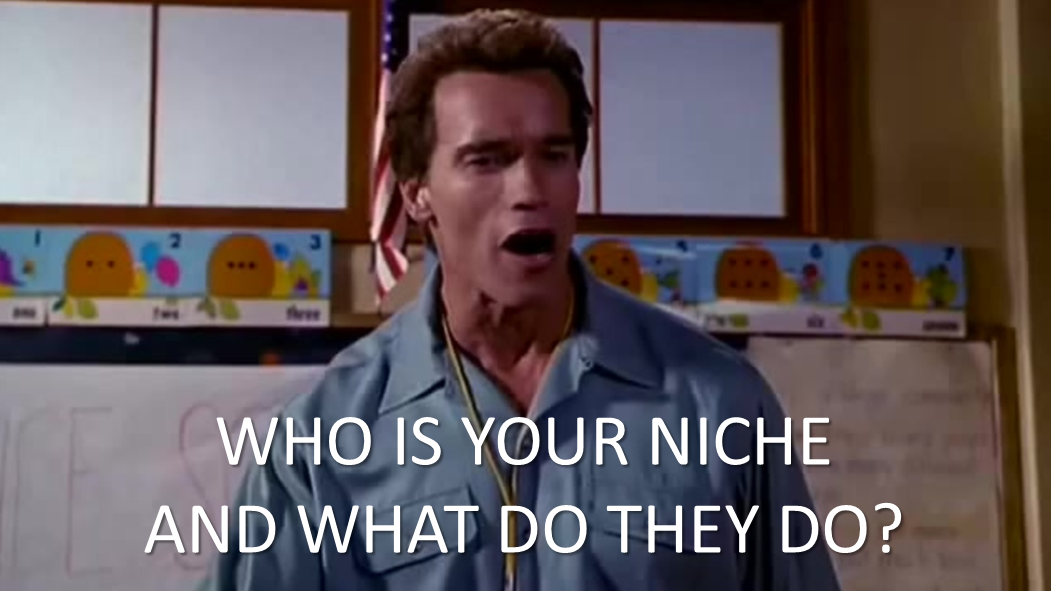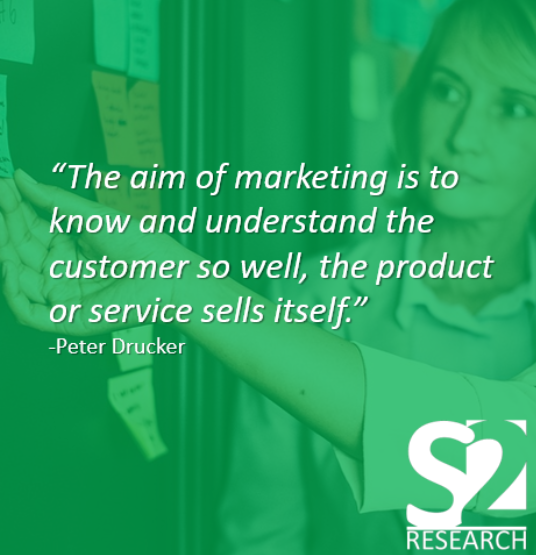That’s marketing, and it’s how the best campaigns work. But unfortunately, in most modern marketing times, this process doesn’t always play out verbatim. With so many demands on marketers’ time, combined with the ever-growing complexity of market research, many marketers simply skip market research altogether. That’s
Read MoreMarketing Strategy
Six Simple Market Research Strategies for Marketing Planning

S2 Research has put together a special White Paper to help you get started with market research for your marketing planning process. In it, we’ve included six simple research tactics you can employ right away to help get your marketing planning process kicked off the right way. You’ll also find a few additional surprises and bonuses, so be sure to keep a look out!
Read MoreResearch is what we do, but insights are what we produce.

When you get something from S2 Research, it usually isn’t research. In fact, that’s the last thing I want to give you. Research is what we do, but insights are what we produce, and it’s insights that I’m interested in delivering!
Read MoreA Vital Part of the Creative Process That You’re Not Doing
When it comes to coming up with creative ideas, we all have our strategies. For some, it’s brain storming. For others, it’s walking away and letting the ideas flow free. And still for some, it’s a clever team meeting process that results in kick-ass ideas. But when it comes to most creative processes, there’s a vital part of the creative process that you’re not doing – great pre-research.
See, what every great creative thinker in the world already knows is that their creativity is based on inputs. They can’t create without building blocks, and for creative ideas, that often means having information.
The critical step for creative marketing.
When it comes to marketing, market research is that critical first step in the creative process. Great marketing is built on great ideas, and you need a foundation for those ideas to take hold. What do you know about your audience that you can reinvent? What types of pain-points are they addressing that you can build a campaign around?
Market research can answer these questions, and help you use the responses to guide next steps.
Think back to Marketing 101.
Classically, the marketing process begins by understanding the customer. A great market research foundation facilitates that need. It dissects who your audience is, and how they think about your product and your industry. It also captures their emotions, their goals, their motivations, and their lives.
Essentially, we’re boiling data down into demographics, psychographics and ethnographics, and reformulating it all into something that’s easy to understand. The information is meant to inform, breaking through biases and preconceived notions, so creative team members can immediately grasp it and do something with it.
Start strong, finish stronger.
Putting effort into the beginning of the process sets the tone and the capabilities. This is true of every project you’ll ever do, but in marketing especially this is the case. Great market research is about learning for the sake of inspiration. It starts with data, but it comes together as insights that create ‘ah-ha’ moments for creative professionals.
If you’re spending time analyzing data, make it your goal to only deliver actionable insights. Don’t worry about sharing the whole set of findings with the creative folks. Instead, highlight the two or three datapoints about your audience that float to the top due to their profoundness, or their difference from the norms. Boil it into the few points that matter most, ignore the rest, and use what’s left as the catalyst for great ideas.
Make it easy to understand.
The challenge in all of this isn’t in the data, and it’s not even in the ideas. It’s in the translation of the two.
When communicating data to marketers, the most important thing a researcher can do is make it easy to understand. Creative teams don’t need all the data – they need the most critical insight you can pull from it. And they need them communicated clearly.
To get going, write down your insights, and start to cross out anything that feels redundant. You’re trying to inspire here, and keeping it short and sweet will help you get there.
Next, ask yourself if there’s more interesting ways to communicate the insights. Could you explain through a metaphor? What about giving examples that exemplify how the audiences thinks and feels?
You can also include diagrams, pictures, graphs, etc. if they focus on conveying the most important parts of the information in the clearest, easiest way. Remember, you’re not limited by anything, so how you choose to communicate your insights is completely up to you!
Finally, consider everything you know about copywriting. You want your insights to be as compelling as possible so everyone can understand them, and a strong background in clever copy will get you there. Just like headline copy, you want to keep your insight short and sweet without losing any of the impact.
Deliver it the right way.
The document with which you organize your insights is how your creative team is going to review them, and it’s up to you to organize it the right way. Often, insights will form into a Creative Brief, which will guide the direction of the creative team’s process. Other times, you might create a one-sheet for a team to review, and you can use bullets, infographs and more to convey everything.
However you choose to go about it, let the ideas come together in a way that tells a story. If your first section is about motivation, make your second section play-off that motivation, telling your readers how the audience goes about achieving their motivations. Altogether, the document should come together as a narrative, painting a picture of your research findings.
Do research to do great work.
Research is the foundation for the greatest campaigns in history. It’s up to marketers and market researchers alike to digest research information, and in most cases, that requires a research summary that conveys without causing the Zzzs.
Research can be dry and it can be boring – if it’s presented wrong. But marketers are creative people with great ideas, and they need something more engaging. Remember, research doesn’t stop at the analysis, but goes a step further into the communication and conveying portion. That final step is critical if you want your research to impact your creative. Take the time, do it right, and you’ll be amazed by the results!
How to Write a Market Research Survey That Performs for Marketers

On the latest episode of Happy Market Research Jamin spoke with Morgan of SurveyMonkey. One of the biggest challenges is in customer experience surveys v. marketing intelligence. That’s why I wanted to write a post on how to write a market research survey that performs for marketers. Surveys are incredibly useful tools, but they take practice and great processes do them right!
Read MoreHow to do Market Research for Marketing

Most people have a vague idea of what Market Research is. But put into practice, that’s not always the case. I wanted to write a little bit about how to do market research for marketing so you can better understand the process that goes into it, and the value that comes from it. Hopefully you’ll be inspired enough to launch your own internal market research project to learn more about your audience!
Read MoreTalking Buyer Personas on the American Marketing Association Las Vegas Podcast

I participated on the American Marketing Association Las Vegas’ Podcast alongside Stormie Andrews of Yokel Local to talk about Buyer Personas. Give the video a watch, and send me an email at Matt@S2Research.com to let me know what you think!
Read MoreSurveys Are More Than Just Report Cards
Surveys are the backbone of market research, because they allow you to gain insight into your respondents. Whether you’re working to understand an entirely new audience, or better hone your insights into your core target base, the ability to ask, receive information, and measure its aggregated findings is pure magic for the marketer. Yet in most modern market research, the survey’s power is harnessed almost exclusively to give a letter grade for the experience alone. Well, I’m here to let you know that surveys are more than just report cards. And while I’ll never deny that gauging satisfaction is critical in customer retention, I want to also remind readers of other important factors that surveys bring to the table.
Digging for treasure
Imagine, for a moment, your customer is standing in front of you. On the back of her head is a treasure chest, and if you open this treasure chest, you can peek directly into her mind. You can learn everything there is to know about what makes this customer your customer.
So, what would you want to know? What would you want to learn, and how could you use this information to better your marketing?
Surveys bring to life this treasure chest analogy. Through advances in the social sciences and the experimentation of market researchers before me, we’ve learned that we can gauge emotion, motivations, pain points, need states, spending habits and more, all through the use of an optimally-designed survey.
Could you do more with more information?
As a marketer, what could you do if you better understood your customers’ need states? If you had a gauge as to what times of day a subset of your audience had need of your services, would you implement a promotion to better capture those customers? Or, if you knew the average customer spent $100/month in your vertical, but only $30/month on your brand, would you create an incentive program to capture a larger share of their spend?
The answer to all of these questions is, of course, of course. As David Ogilvy, the father of advertising, famously put it:
“Advertising people who ignore research are as dangerous as generals who ignore decodes of enemy signals.”
Research gives us the playbook, and the playbook of our opposition as well. We learn what we’re up against, what strategies will be most effective, and how it can all come together to work in your favor.
Ask the right questions to get the right answers
So, we’ve established that surveys can yield great information – great data – but how, exactly, does one ask the right questions?
This is the art that gets me so-often so-excited about this field. To ask the right questions takes a lot of practice, a lot of experience, and a lot of (hold your laughs) research. That’s because not all data is equal, and not all responses as relevant or insightful as you might think.
Increase engagement to gain deeper insights
What we’ve learned over the past several decades is that you need to attack psychological data-gathering indirectly. This might mean leading the respondent down a path where their answers become more genuine, or adding preliminary questions to help them enter the right state of mind.
A few years ago I had the chance to gauge brand awareness for a local home services provider. In one question, we asked respondents to name the first three companies in various home-service verticals that came to mind. Ultimately, we were able to measure that the client not only had the No. 2 brand in the market, but we also identified some verticals where the client had opportunity to grow market share as well.
Two years ago, I had the opportunity to sit in on a presentation called “Gamify Your Research.” In a nutshell, the premise was to take the engaging components of several common games and incorporate them into survey design. An example they gave was a similar project to my home services brand awareness study, except in their study the respondent was given 30 seconds to name as many brands as they could in the vertical. The result was a deeper dive, greater engagement, and more genuine data.
This is the kind of new research tool that is drastically changing how we do what we do. When the timed respondent gave their responses, they were more focused, more engaged, more genuine, and closer in the mindset they would be when they are in need of the service. That last point is key – we must consider the mindset the respondent is in during their responses.
I’m looking forward to the opportunity to work with projects like this again, so I can implement such a cool methodology and see how it yields more meaningful results.
Build audiences around insights
Of course, the most valuable data in the world is still meaningless if we don’t take the time to properly analyze it. And thanks to advances in data analysis, data visualization and other technological arenas, this ability is more insightful than ever before.
For audience data to benefit you, you’ll need to sift through your data to find the nuggets of information most valuable to your goals. You’ll also need to understand the commonalities of the respondents in those categories.
In other words, you need to build audiences. If a third of the respondents express the same, untapped need-state, what is it that makes them all similar? If a quarter of your audience demonstrates a desire to buy following the same major life event, can you develop a campaign that addresses that event?
Building audiences from data, and deriving actionable insights about those audiences, is the most critical component of effective survey research.
Market research is everywhere
Surveys are more than just report cards. But if you’ve received a receipt for a small transaction – nearly any transaction – in the past ten years, there’s a very good chance you’ve been asked to take a survey that does exactly that.
The takeaway from this is that surveys and platforms are already available, and customers are primed and ready to participate. If you’re looking to enhance your audience ask so you can better know the people who buy from you, contact S2 Research.
Branding in Marketing

Something interesting in the world of branding happened this week. A principal of a high school in New Orleans politely refused to accept free food from a local Chick-fil-A. His reasoning was that the company’s opinion of the LGBTQ community was out of alignment with the school’s own values, and that it would be disrespectful to his LGBTQ staff and faculty members to accept the gesture.
Read MoreHow to do Branding for Niche Audiences

Learn all about how to reach niche audiences with great lessons from some of the biggest brands in fast food.
Read MoreWithout Data, You’re Just Another Person with an Opinion

“Without data, you’re just another person with an opinion.” W. Edwards Deming, famed data analyst, said this great quote, and for me, it’s the ultimate MacGuffin.
Read MoreIf You Know More You Can Do More

When it comes to marketing, we all seem to agree that audience knowledge matters. But with most marketers, knowledge comes from their experience in the industry – and if you don’t have any, tough dice. So, what happens when someone wants to enter a new market or reach a new audience?
Read MoreWhy Market Research?

Since I’ve started in marketing, I’ve often been asked “Why market research?” There’s PR, there’s digital, there’s grassroots, there’s direct, and there’s a few dozen other ways that you can make it in this business. So, why market research?
Let me tell you a story.
Read More










